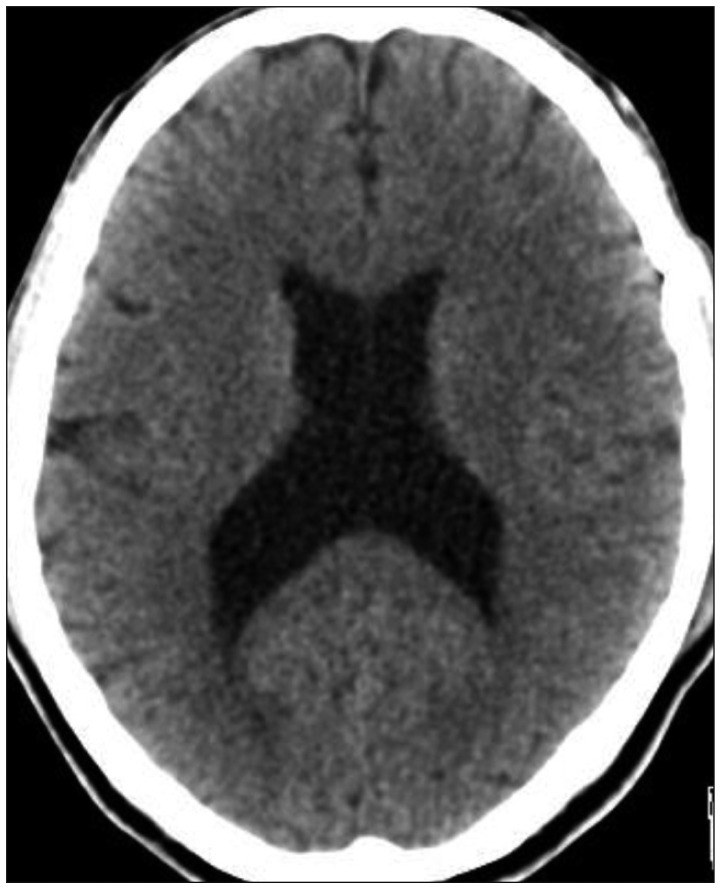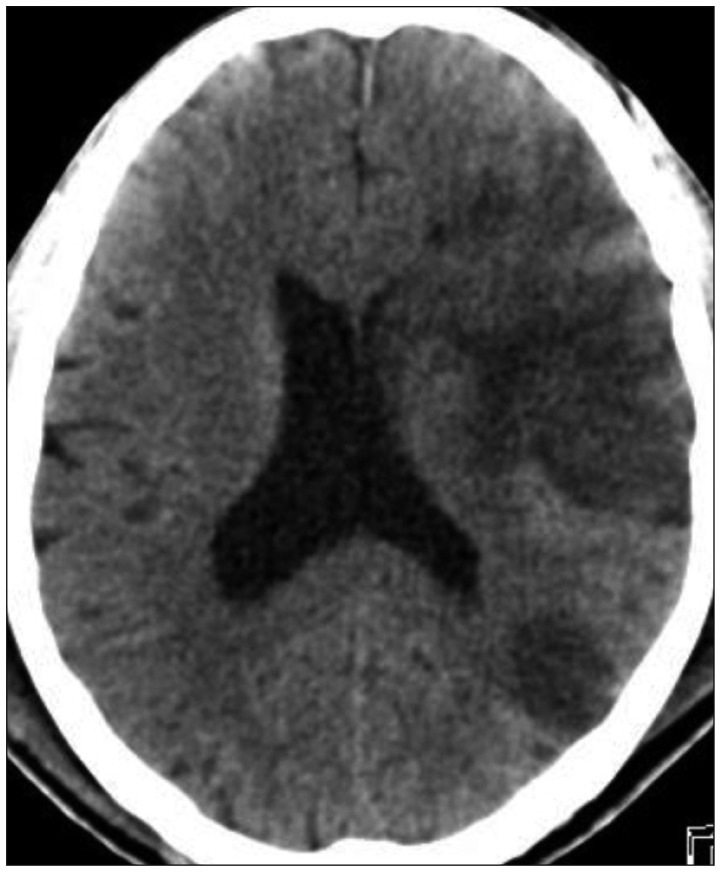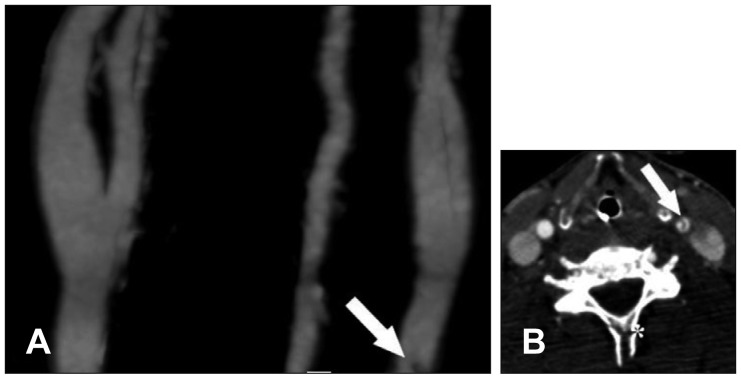Korean J Neurotrauma.
2018 Apr;14(1):28-31. 10.13004/kjnt.2018.14.1.28.
Common Carotid Artery Dissection in Multiple Extracranial Injury: A Case Report
- Affiliations
-
- 1Department of Neurosurgery, Wonkwang University Hospital, Wonkwang University School of Medicine, Iksan, Korea. kseom@wonkwang.ac.kr
- 2Department of Thoracic and Cardiovascular Surgery, Wonkwang University Hospital, Wonkwang University School of Medicine, Iksan, Korea.
- KMID: 2410918
- DOI: http://doi.org/10.13004/kjnt.2018.14.1.28
Abstract
- Traumatic common carotid artery dissection (CCAD) is rare. To our knowledge, only 14 case reports have described traumatic CCAD previously. Here, we report a case of CCAD in a patient with severe trauma. A 50-year-old man was lying on the road after drinking alcohol when a car drove over him. Computed tomography (CT) revealed multiple rib fractures with hemopneumothorax, lung contusion, flail chest, large amount of hematoma with bladder rupture, and fractures on the C6 spinous process, sacral ala, iliac bone, and pubic ramus. Repair of the bladder rupture, exploratory thoracotomy, and open reduction of multiple rib fractures were performed. Right side hemiparesis was observed on hospital day 4. Brain CT showed a large acute left middle cerebral artery infarction. CT angiography showed focal carotid dissection at the left common carotid artery with intimal flap. The CCAD was located at the C6 level. Clexane (enoxaparin sodium) treatment was initiated. An abdominal CT scan revealed a huge retroperitoneal hematoma and increased amount of hematoma in the prevesical and perivesical space, 10 days later. The patient died two days later. Although traumatic CCAD is rare, this case report provides useful information for trauma surgeons regarding the treatment and diagnosis of similar cases.
MeSH Terms
Figure
Reference
-
1. Bogousslavsky J, Pierre P. Ischemic stroke in patients under age 45. Neurol Clin. 1992; 10:113–124. PMID: 1556998.
Article2. Chen YC, Lee TH, Chen CJ, Chen ST. Spontaneous common carotid artery dissection: a case report and review of the literature. Eur Neurol. 2003; 50:58–60. PMID: 12824716.
Article3. Chokyu I, Tsumoto T, Miyamoto T, Yamaga H, Terada T, Itakura T. Traumatic bilateral common carotid artery dissection due to strangulation. A case report. Interv Neuroradiol. 2006; 12:149–154. PMID: 20569567.4. Cimini N, D'Andrea P, Gentile M, Berletti R, Ferracci F, Candeago RM, et al. Cervical artery dissection: a 5-year prospective study in the Belluno district. Eur Neurol. 2004; 52:207–210. PMID: 15539774.
Article5. Krajewski LP, Hertzer NR. Blunt carotid artery trauma: report of two cases and review of the literature. Ann Surg. 1980; 191:341–346. PMID: 7362300.
Article6. Lyrer P, Engelter S. Antithrombotic drugs for carotid artery dissection. Cochrane Database Syst Rev. 2010; CD000255. PMID: 20927720.
Article7. Mokri B. Traumatic and spontaneous extracranial internal carotid artery dissections. J Neurol. 1990; 237:356–361. PMID: 2277269.
Article8. Perry MO, Snyder WH, Thal ER. Carotid artery injuries caused by blunt trauma. Ann Surg. 1980; 192:74–77. PMID: 7406566.
Article9. Schievink WI, Mokri B, O'Fallon WM. Recurrent spontaneous cervical-artery dissection. N Engl J Med. 1994; 330:393–397. PMID: 8284004.
Article10. Schievink WI, Mokri B, Whisnant JP. Internal carotid artery dissection in a community. Rochester, Minnesota, 1987–1992. Stroke. 1993; 24:1678–1680. PMID: 8236342.
Article11. Srivastava T, Nagpal K. Traumatic dissection of common carotid artery due to injury caused by a tiger. J Pediatr Neurosci. 2013; 8:261–261. PMID: 24470833.
Article12. Steinke W, Rautenberg W, Schwartz A, Hennerici M. Noninvasive monitoring of internal carotid artery dissection. Stroke. 1994; 25:998–1005. PMID: 7909394.
Article13. Sturzenegger M. Spontaneous internal carotid artery dissection: early diagnosis and management in 44 patients. J Neurol. 1995; 242:231–238. PMID: 7798122.
Article14. Tür FÇ, Aksay E, Atilla ÖD. Asymptomatic traumatic common carotid artery dissection. Chin J Traumatol. 2015; 18:44–45. PMID: 26169095.15. Weinberger J, Rudolph S, Lidov M. Evidence for arterial embolization in dissecting aneurysm of the cervical vertebral artery. J Stroke Cerebrovasc Dis. 1991; 1:95–97. PMID: 26487601.
Article16. Yamada S, Kindt GW, Youmans JR. Carotid artery occlusion due to nonpenetrating injury. J Trauma. 1967; 7:333–342. PMID: 6024135.
Article17. Zach V, Zhovtis S, Kirchoff-Torres KF, Weinberger JM. Common carotid artery dissection: a case report and review of the literature. J Stroke Cerebrovasc Dis. 2012; 21:52–60. PMID: 20851634.
Article18. Zetterling M, Carlström C, Konrad P. Internal carotid artery dissection. Acta Neurol Scand. 2000; 101:1–7. PMID: 10660144.
- Full Text Links
- Actions
-
Cited
- CITED
-
- Close
- Share
- Similar articles
-
- Treatment of Internal Carotid Artery Dissections with Endovascular Stent Placement: Report of Two Cases
- Asymptomatic Extracranial Internal Carotid Artery Aneurysm: A Case Report
- Endovascular Stent Treatment for Traumatic Common Carotid Artery Dissection with Cerebral Infarction : Case Report and Literature Review
- Extracranial Carotid Disease: An Interpretation of Extracranial Carotid Artery Disease Guideline 2011
- Coexisting Dissecting Aneurysms of the Internal Carotid and Basilar Arteries Following Flexion Injury: Case Report





